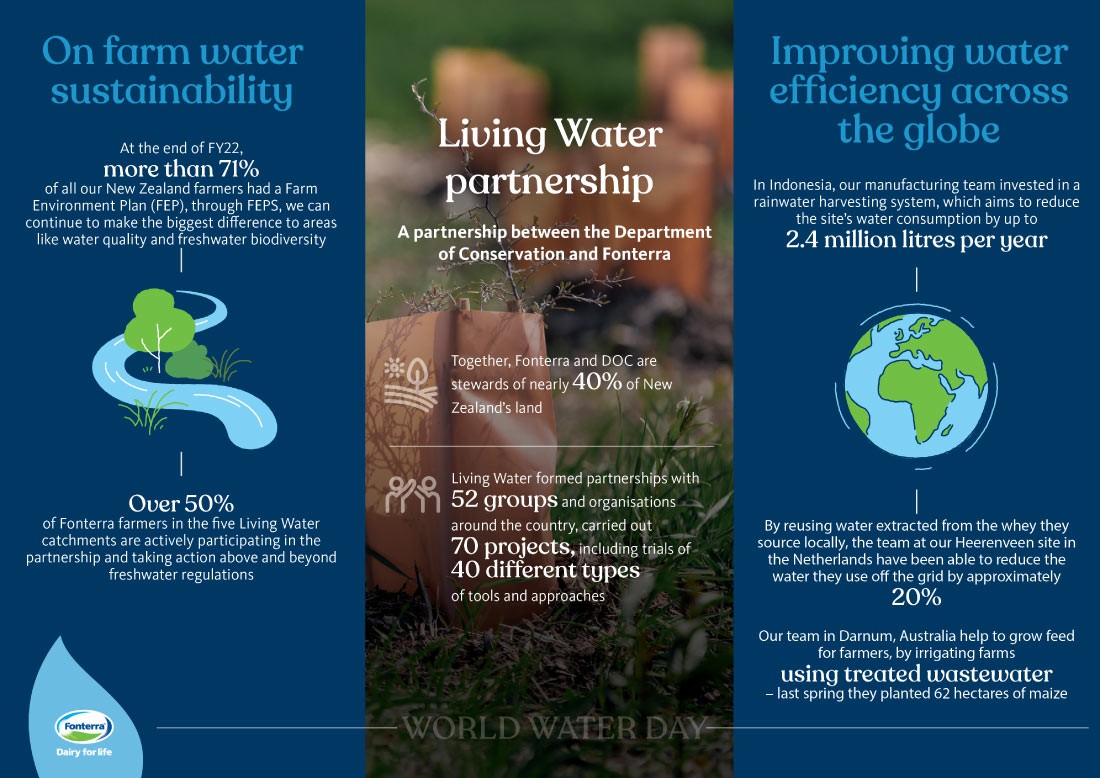World Water Day: How we are protecting and conserving water across the Co-op
March 22nd is World Water Day, with the global theme ‘Accelerate Change’, focusing on how everyone has a part to play to protect water.
The day is a great opportunity to check in on the progress on initiatives both in New Zealand and around the globe – to protect and regenerate waterways, reduce our water use, and improve water quality through farm system and management improvements.

Celebrating ten years of Living Water in New Zealand
Our Living Water partnership began in 2013 and is now celebrating its 10th and final year.
The partnership between Fonterra and the Department of Conservation (DOC) has trialled tools and approaches to enable farming, freshwater and healthy ecosystems to thrive side-by-side.
The trials, approaches, and all the lessons learnt and failures from Living Water are being shared with organisations, farmers and interested individuals across New Zealand., to enable and accelerate change.
Here are a few important things we’ve learned in those ten years:
1. The power of partnership
Together, Fonterra and DOC are stewards of nearly 40% of New Zealand’s land. We joined forces because we knew we could make more of an impact working together for freshwater and biodiversity than we could individually.
Living Water has provided an opportunity to forge new partnerships with farmers, scientists, councils, mana whenua (Māori who have historic rights over the land) and local communities to make a real difference for freshwater, ecological health and farming in New Zealand.
Together with DOC, we have:
- Formed partnerships with 52 groups and organisations around the country to help co-design and deliver our projects
- Carried out 70 projects, including trials of 40 different types of tools and approaches
- Nine of these solutions have been adopted by other organisations
- See all the trials here.
2. The importance of science & new technology
New Zealand is one of the most geologically diverse countries in the world. There can be very different nutrient losses from farm to farm because of the differences in land characteristics. In some places, the landscape characteristics alone can be responsible for at least two times the variation in water quality compared to the type of land use on its own.
The LandscapeDNA tool – created by Land & Water Science and supported by Living Water, aims to reveal the characteristics of a landscape so farmers and landowners can make informed decisions about the best use of their land, to reduce negative environmental impacts.
This is hugely significant because farmers have been changing aspects of their farming practices, which can be frustrating when there is little effect.
The LandscapeDNA project provides an in-depth picture of landscape characteristics under our feet which will enable farmers to understand why and how their land is contributing to water quality, and what decisions they need to make about future land management to improve water quality. Find out more here.
3. The choices people make are just as vital as the science
People are at the heart of improving water quality and biodiversity.
It is as much about changing people’s mindsets as it is about changing farm practices.
Farmers have responded well to Living Water, with over 50% of Fonterra farmers in the five pilot catchments actively participating in the partnership and taking action above and beyond freshwater regulation.
Making the most of Mother Nature in Indonesia
Our manufacturing team in Indonesia has invested in a rainwater harvesting system, which aims to reduce the site’s water consumption by up to 20% per year – an annual saving of 2.4 million litres!
The climate of Indonesia hot, humid and rainy throughout the year. In Jakarta, where our factory and the rainwater harvesting system is, it rains for around 250 days of the year.
The system collects water from surfaces rained on and stores it in a tank. Collected water is then used for amenities and surrounding needs such as the locker area, mosque, toilet, canteen and the fire tank.
In the first week of operation the system saved 18% of the water amount normally used.
By investing in this system we are showing that we are serious about sustainability and helping the Co-op to meet its target of a 30% reduction in water consumption by 2030
Using excess water to grow feed for farmers in Australia
In Australia, water plays important part in making many of our dairy foods.
Adjoining our Darnum, Cobden and Stanhope sites, is about 590 hectares of farmland, which is owned by the Co-op. This land is used to grow crops, and it gives us a place to irrigate our wastewater.
Once the wastewater is treated, the water contains valuable nutrients. The type of crops we plant maximises the uptake of those nutrients, so they don’t build up in the soil.
Our environmental teams at each site work closely with local farmers to manage the activities on these farms, and in turn the farmers get to keep the harvest for stockfeed – creating a truly circular economy of returning waste back to the primary product.
Our Darnum team have seen some fantastic results with this program –planting 62 hectares of maize during spring. The harvest from the maize results in a significant increase in nutrient absorption from the farm – a key objective for a successful irrigation scheme.

